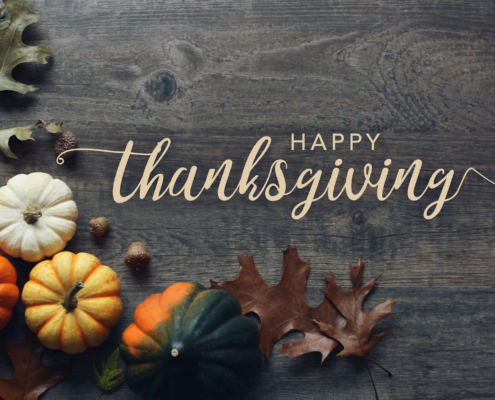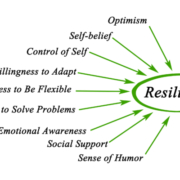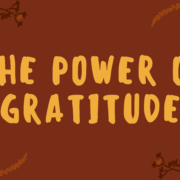Holiday Tips: Practicing Gratitude and a Special Thanksgiving Stuffing Recipe
Thanksgiving is one of my favorite holidays—a time for family to gather and a present-moment reminder to practice gratitude. You might be feeling stressed, sad, discouraged, anxious, fearful, or just angry at times. What can we do to manage our feelings better and how can gratitude really help with anxiety?
The Power of Gratitude
I discovered the power of gratitude when I learned about the neuroscience of emotional intelligence. Practicing a daily acknowledgment of who and what we are grateful for can be life-changing. In fact, studies have shown how gratitude can shield you from the blues, promote optimism, and make you feel happier. In a nutshell, appreciation can be your antidote to fear and anxiety.
Practicing gratitude is a key component of emotional intelligence in two ways:
- Emotional self-awareness: “Is your glass half empty or half full? Am I grateful or ungrateful?”
- Emotional management: “How can I create a daily ritual and have my own appreciation act as an anchor for myself and others?”
Having an intentional focus on people and things that you’re grateful for also strengthens empathy and helps build stronger relationships with others. Gratitude is a powerful human emotion and can be utilized to help us self-soothe when we’re feeling anxiety and fear.

How Anxiety Protects Us
How exactly does anxiety protect us? Anxiety is our body’s internal system that alerts us against danger. When we feel anxiety or fear, hormones are released in our body that create a fight or flight response so we can react quickly to a potentially dangerous situation. Our brain doesn’t get much time to analyze between right and wrong when the adrenaline rush begins. A negative side effect of anxiety is that it makes us feel insecure and we start questioning our inner self-worth. Eventually, our ability to cope and our support systems start failing.
In his book, What Happy People Know, Dan Baker reasons that you can’t be in a state of appreciation and fear, or anxiety, at the same time. He shares:
“During active appreciation, the threatening messages from your amygdala [fear center of the brain] and the anxious instincts of your brainstem are cut off, suddenly and surely, from access to your brain’s neocortex, where they can fester, replicate themselves, and turn your stream of thoughts into a cold river of dread. It is a fact of neurology that the brain cannot be in a state of appreciation and a state of fear at the same time. The two states may alternate, but are mutually exclusive.”
Baker’s conclusion is that by consciously practicing gratitude, we reduce anxiety and feelings of apprehension by training the brain to attend selectively to positive emotions and thoughts.

The Physical, Social, and Mental Benefits of Gratitude
Gratitude improves our personal relationships at home and work. This connection between happiness and gratitude is multi-faceted. Expressing appreciation (not only to others but also to ourselves) induces positive emotions—primarily happiness. Gratitude impacts our overall health and well-being by producing feelings of pleasure and contentment.
Taking time to know your “appreciation anchor” (for example, somewhere where you feel content and comfortable like the beach, mountains, or walking your dog) and envisioning it when you’re feeling stress or anxiety will help you self-soothe in the moment.
Easy rituals like maintaining a gratitude journal, complimenting yourself, or sending a thank you note can make you feel a lot better and enhance your mood immediately.
As you pause from the bustle of life this Thanksgiving, I hope you can join me in acknowledging those cheerful moments with your friends and family. The simple act of gratitude has a far greater impact than you might imagine. Thanking yourself, others, God, or Mother Nature will make you and others happier. At the Southwest Institute for Emotional Intelligence, we know that emotions are contagious so please share this blog post with your community.
Saving the Best for Last
I can’t imagine a more fun way to close out this holiday-themed blog post than sharing a very special Thanksgiving stuffing recipe. I’m truly grateful for my mother, Betty Seredich, who’s a wonderful cook and an amazing mom. She’s 100% Italian and owned a restaurant for years. I thought it would be nice to share her Thanksgiving stuffing recipe. Please find the special recipe below.

Thanksgiving Stuffing with Italian Sausage
12 oz. Pepper Ridge Farms cubed bread dressing
½ cup chopped celery
½ cup chopped carrots
½ cup of chopped white or yellow onions
½ teaspoon of parsley
¼ teaspoon of rosemary
¼ teaspoon of thyme
2 cloves of fresh garlic or 1 teaspoon of minced garlic
¼ cup of apple cider
½ cup of soft butter unsalted
1 egg
1 lb. of Italian sweet or mild sausage cooked (sauteed in a skillet with ½ teaspoon of olive oil and out of the casing)
1 cup of chicken broth
Preheat the oven to 350 degrees.
Start with cooking the mild or sweet Italian sausage. Take the sausage out of the casing and sauté it in a skillet with ½ teaspoon of olive oil or cooking spray.
In a large bowl, add the bread dressing, carrots, celery, onions, all dry ingredients, garlic, butter, and cooked sausage together and mix it. Then, add apple cider and chicken broth to the whisked egg and mix it all together in the larger bowl. Use an 8” x 11” buttered baking dish and pour in the mixture. Bake uncovered for 25 minutes at 350 degrees. Enjoy!
I am grateful for being able to share my blog with others and so thankful for my family, friends, and clients. I hope you have a very Happy Thanksgiving holiday!
If you would like to learn more about EI, register for our Leader with Emotional Intelligence Immersive Online Course starting on January 23, 2023. Click here for more information.
Bobi Seredich is the Co-Founder of the Southwest Institute for Emotional Intelligence in Phoenix, Arizona. She can be reached at bobi@swiei.com.











